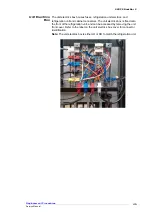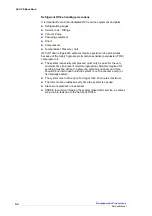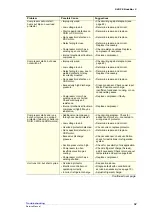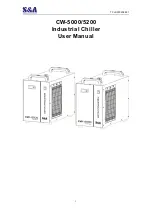
49
SKOPE BackBar X
Replacement Procedures
Service Manual
Recommended
Service
Procedures
SKOPE recommend the SKOPE Cyclone® demountability and exchangea-
bility philosophy, which in essence means:
The customer must not be inconvenienced during system maintenance.
In the unlikely event of Refrigeration failure, an exchange unit is simply
swapped in a matter of minutes. There is no cabinet down time or unloading
product. In one short visit, the customer's inconvenience ends. The faulty
Cyclone® is then removed to the workshop for repair as time allows.
For a suspected refrigerant problem
Disconnect the evaporator fan motor and with the system running, a ‘frost
line’ will become obvious (after approximately 5 minutes): Entire evaporator,
accumulator, and suction line right up to compressor must be frosting.
Compressor at suction inlet will sweat.
If these conditions are not met, the system is faulty, either short of refriger-
ant, compressor not pumping efficiently, or capillary restriction. The system
must then be opened (see Refrigerant R134a Handling Precautions section)
and gauges temporarily fitted (i.e. either temporarily fit line piercing valves,
or braze in service lines).
Short of refrigerant
Where the frosting effect is shorter than required (unless all refrigerant is
lost, where there is no frosting effect). Only a small amount of refrigerant will
exit the system. A leak test (refrigerant / dry nitrogen mix, up to 250 psig)
should be performed to locate the leak. If no leak is found, a pressure test
should be performed (dry nitrogen only, up to 250 psig) if there is no pres-
sure drop over 24 hours, the fault should be treated as a capillary restriction.
Compressor not pumping efficiently
Where the frosting effect is not as cold as it should be. Symptoms include:
compressor body hotter than normal, condenser cooler than normal, and the
compressor may make an unusual hissing sound. All of these symptoms
depend on the severity of the problem.
The only way to prove a pumping problem is to perform a compressor pump-
down test: braze closed compressor suction line, open discharge line; then
run the compressor to pull a vacuum on a vacuum gauge.
The compressor should pull down to approximately 30" Hg (inches of mercu-
ry) or 101 kPa vacuum, then turn the compressor off and this vacuum must
be held without any loss for 5 minutes. If the Compressor does not pass
these tests; it is not pumping efficiently and must be replaced.
There are different methods to proving pumping efficiency. If the test is
performed with a system charged with refrigerant, a deep vacuum will not be
achieved.
Capillary restriction
With a totally blocked capillary, there will be no refrigeration effect. A partially
blocked capillary may have similar symptoms to a system being short of
refrigerant. Flush a restricted capillary with dry nitrogen. If the capillary will
not clear, it must be replaced.
After the repair, the drier must be replaced. The Cyclone® must be fully
evacuated and charged to the volume of refrigerant indicated on the
Cyclone® serial/rating label. All service lines must be purged.
Finally, pinch-off the gauge process lines (or remove line piercing valves)
and braze the system closed. SKOPE recommend against leaving service
valves in the system as these are prone to leak (and are open to abuse).
Perform a final system leak test.











































